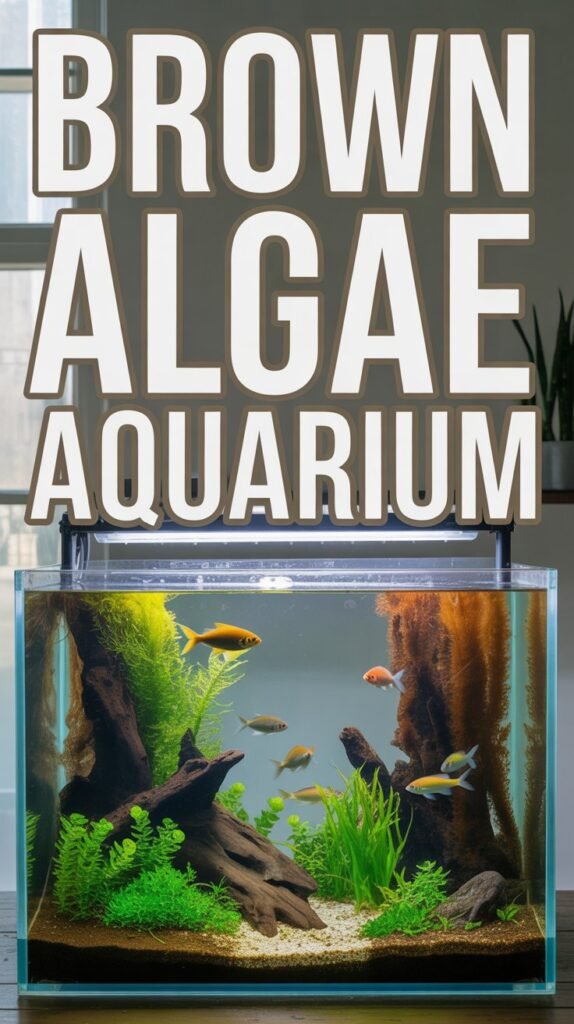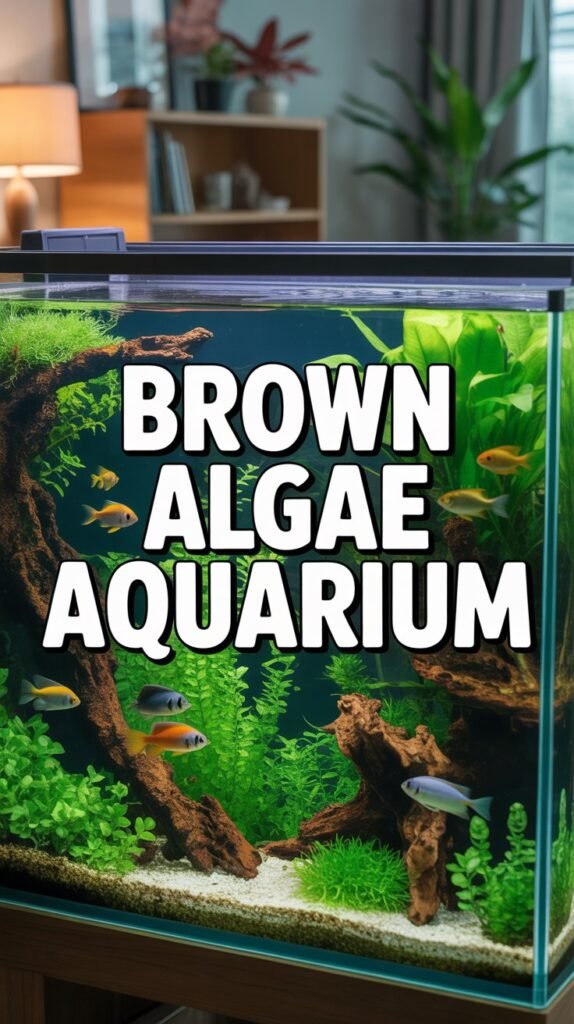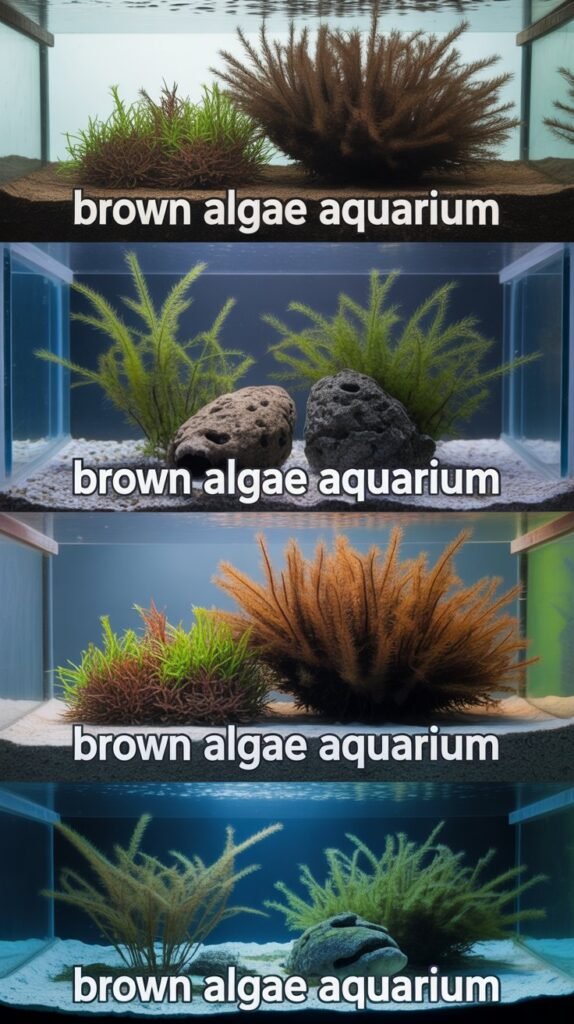Brown algae are among the most common problems aquarium keepers face, especially in new or poorly balanced tanks. Though it may look alarming, brown algae—scientifically known as diatoms—are usually not dangerous to fish or plants. However, their fast spread and unsightly appearance can quickly ruin the look of your aquarium.
This detailed guide will explore everything you need to know about brown algae in aquariums, including what causes it, how to remove it, and how to prevent it from returning. Whether you’re a beginner or an experienced aquarist, understanding brown algae is essential for maintaining a clean, healthy, and visually appealing aquarium environment.
What Is Brown Algae in Aquariums?
Brown algae are actually diatoms, a type of single-celled organism that thrives in aquatic environments. Unlike green algae, which rely heavily on light, brown algae prefer low-light and nutrient-rich conditions. They form a soft brown or rust-colored film on aquarium glass, substrate, plants, and decorations.
Diatoms have cell walls made of silica, giving them a unique texture and structure. While they can occur in both freshwater and saltwater aquariums, they are most commonly found in newly established tanks or tanks with poor water balance.
Identifying Brown Algae

Recognizing brown algae is easy once you know what to look for:
- Color: Ranges from light brown to dark rust or golden brown.
- Texture: Soft, dusty, and easily wipes off surfaces with your fingers.
- Location: Typically found on aquarium glass, plants, substrate, driftwood, and rocks.
- Growth Pattern: Spreads quickly in low-light areas or on surfaces with little water flow.
If you notice a brown film appearing on your tank within the first few weeks of setup, it’s almost certainly a diatom bloom.
Causes of Brown Algae in Aquariums
Brown algae growth can be triggered by various factors. Understanding these causes helps you address the root of the problem rather than just treating the symptoms.
1. New Tank Syndrome (Uncycled Aquariums)
One of the most common causes is a new or uncycled aquarium. In a newly set-up tank, the beneficial bacteria that process waste haven’t fully developed yet. The imbalance in nutrients provides an ideal environment for diatoms to grow.
2. Excess Silicates
Brown algae require silica (SiO₂) to build their cell walls. Silicates can come from:
- Tap water (especially hard water)
- Sand or gravel substrate
- Aquarium decorations made of silica-based materials
High silicate levels create a perfect breeding ground for diatoms.
3. Low Light Conditions
Unlike other algae that thrive in strong light, brown algae prefer dimly lit aquariums. Tanks with low lighting or limited exposure to natural light are more prone to brown algae growth.
4. Poor Water Quality
Brown algae often appear when the water quality deteriorates. Factors such as high nitrates, phosphates, and organic waste can accelerate their growth.
5. Inadequate Water Flow
Stagnant water or low circulation encourages diatom accumulation on surfaces. Proper water movement helps prevent debris buildup and keeps algae spores from settling.
6. Overfeeding
Overfeeding fish leads to leftover food decomposing in the water, increasing nutrient levels. These excess nutrients provide a food source for brown algae.
Effects of Brown Algae on Your Aquarium

While brown algae don’t directly harm fish or plants, their presence can cause several indirect problems:
- Aesthetic issues: They make the tank look dirty and unappealing.
- Reduced light penetration: Thick algae layers block light from reaching plants.
- Oxygen fluctuations: Heavy algae growth can interfere with oxygen exchange.
- Nutrient competition: In planted tanks, algae can compete with live plants for essential nutrients.
If left unchecked, brown algae can dominate the aquarium environment, making it more difficult to restore balance later.
How to Remove Brown Algae from Aquariums
Fortunately, brown algae are relatively easy to remove compared to other algae types. Here’s how to clean your tank effectively:
1. Manual Cleaning
Start by physically removing visible algae:
- Wipe the glass with an algae scraper or sponge.
- Remove algae from decorations and rocks with a soft brush.
- Gently rub affected plant leaves using your fingers or a cloth.
Manual cleaning should be done regularly to prevent buildup.
2. Water Changes
Perform 25–50% water changes weekly to remove excess nutrients. Use dechlorinated or filtered water to avoid introducing silicates or phosphates.
3. Improve Water Circulation
Install a stronger filter or add an air stone to increase oxygen levels and water flow. Good circulation helps prevent algae from settling on surfaces.
4. Reduce Silicates
Use RO (reverse osmosis) water for your tank to eliminate silicates and minerals that promote diatom growth. Silicate-absorbing resins or pads can also be used in filters.
5. Adjust Lighting
Increase light intensity gradually if your tank is too dim. However, avoid keeping the light on for more than 8–10 hours per day, as this can encourage other algae types.
6. Add Algae-Eating Species
Introducing natural cleaners can help control brown algae growth:
- Otocinclus catfish
- Siamese algae eaters
- Nerite snails
- Amano shrimp
These species consume brown algae and keep surfaces clean naturally.
7. Monitor Feeding Habits
Feed your fish only what they can eat in 1–2 minutes. Remove uneaten food promptly to avoid nutrient spikes.
8. Check Filter Media
Rinse or replace old filter media regularly. Clogged filters can lead to poor water quality, increasing the risk of algae outbreaks.
Preventing Brown Algae in Aquariums

Once you’ve removed brown algae, prevention is key to keeping your aquarium healthy and beautiful.
1. Cycle the Aquarium Properly
Before adding fish, allow your aquarium to fully cycle for at least 3–6 weeks. This process establishes beneficial bacteria that regulate ammonia and nitrite levels.
2. Use Quality Water
Avoid using untreated tap water with high silicate content. RO or DI water is the best option for algae prevention.
3. Maintain Proper Lighting
Provide adequate lighting for plants, but don’t overdo it. Adjust your light duration and intensity according to your tank type.
4. Regular Maintenance
Consistent maintenance routines—including cleaning, water changes, and monitoring water parameters—are vital to prevent algae from taking hold.
5. Monitor Nutrient Levels
Keep an eye on nitrate, phosphate, and silicate levels using aquarium test kits. Ideal nitrate levels should be below 20 ppm.
6. Keep a Balanced Ecosystem
A balanced tank with healthy plants, proper filtration, and algae-eating species naturally discourages brown algae growth.
Brown Algae vs. Other Types of Algae
It’s essential to distinguish brown algae from other types:
| Type of Algae | Color | Texture | Common Cause | Solution |
|---|---|---|---|---|
| Brown (Diatoms) | Brown or rusty | Dusty, wipes off easily | Silicates, low light | Improve water quality, add algae eaters |
| Green Algae | Bright green | Slimy or fuzzy | Too much light, excess nutrients | Control lighting, reduce feeding |
| Blue-Green Algae (Cyanobacteria) | Dark green-blue | Slime-like, smells bad | Poor circulation, high nutrients | Improve flow, water changes |
| Black Beard Algae | Black or dark gray | Fuzzy, tough | CO₂ imbalance | Prune plants, adjust CO₂ levels |
Recognizing which algae type you’re dealing with helps apply the correct treatment.
The Role of Live Plants in Preventing Brown Algae
Live aquarium plants are one of the best natural defenses against brown algae. They absorb excess nutrients that algae would otherwise use to grow. Fast-growing species like Hornwort, Amazon Sword, or Water Wisteria are especially effective.
Healthy plants also improve oxygen levels and overall water quality, making it harder for algae to dominate.
When to Seek Expert Help
If brown algae persist even after following these steps, you might need to:
- Test for hidden silicate sources (substrate, decorations, etc.)
- Replace your lighting system if it’s too weak or old
- Review your filtration and water change schedule
Persistent issues may indicate a deeper imbalance in your aquarium ecosystem.
Conclusion
Brown algae (diatoms) are a common nuisance in aquariums, especially during the early stages of setup. While not harmful, their growth signals an imbalance that needs attention. By understanding their causes—such as silicates, poor lighting, and excess nutrients—you can take effective measures to remove and prevent them.
Maintaining a balanced aquarium through regular cleaning, proper filtration, and the use of algae-eating species ensures your tank remains healthy, beautiful, and algae-free.
Frequently Asked Questions (FAQs)
1. Is brown algae harmful to fish?
No, brown algae are not toxic or harmful to fish. They’re primarily a visual problem and can indicate poor water conditions.
2. Why does brown algae keep coming back?
Recurring brown algae usually mean silicate or nutrient levels remain high, or the tank hasn’t fully cycled yet.
3. Will algae eaters completely remove brown algae?
Algae eaters like Otocinclus catfish and Nerite snails help control brown algae, but manual cleaning and maintenance are still necessary.
4. Does brown algae go away on its own?
In most new aquariums, brown algae disappear naturally once the tank stabilizes and beneficial bacteria establish.
5. Can I use chemicals to remove brown algae?
Chemical treatments are not recommended. Addressing the root causes—light, nutrients, and water quality—is the safest and most effective solution.
6. How long does it take to get rid of brown algae?
With proper care and maintenance, brown algae typically clear up within 2–4 weeks.
7. Can brown algae grow on live plants?
Yes, they can coat plant leaves, blocking light and slowing growth. Gently clean the leaves to avoid damaging the plants.
Final Tip:
Keep your aquarium balanced, perform regular maintenance, and monitor water parameters closely. Over time, your tank will stabilize, and brown algae will become a rare occurrence rather than a recurring nuisance.
